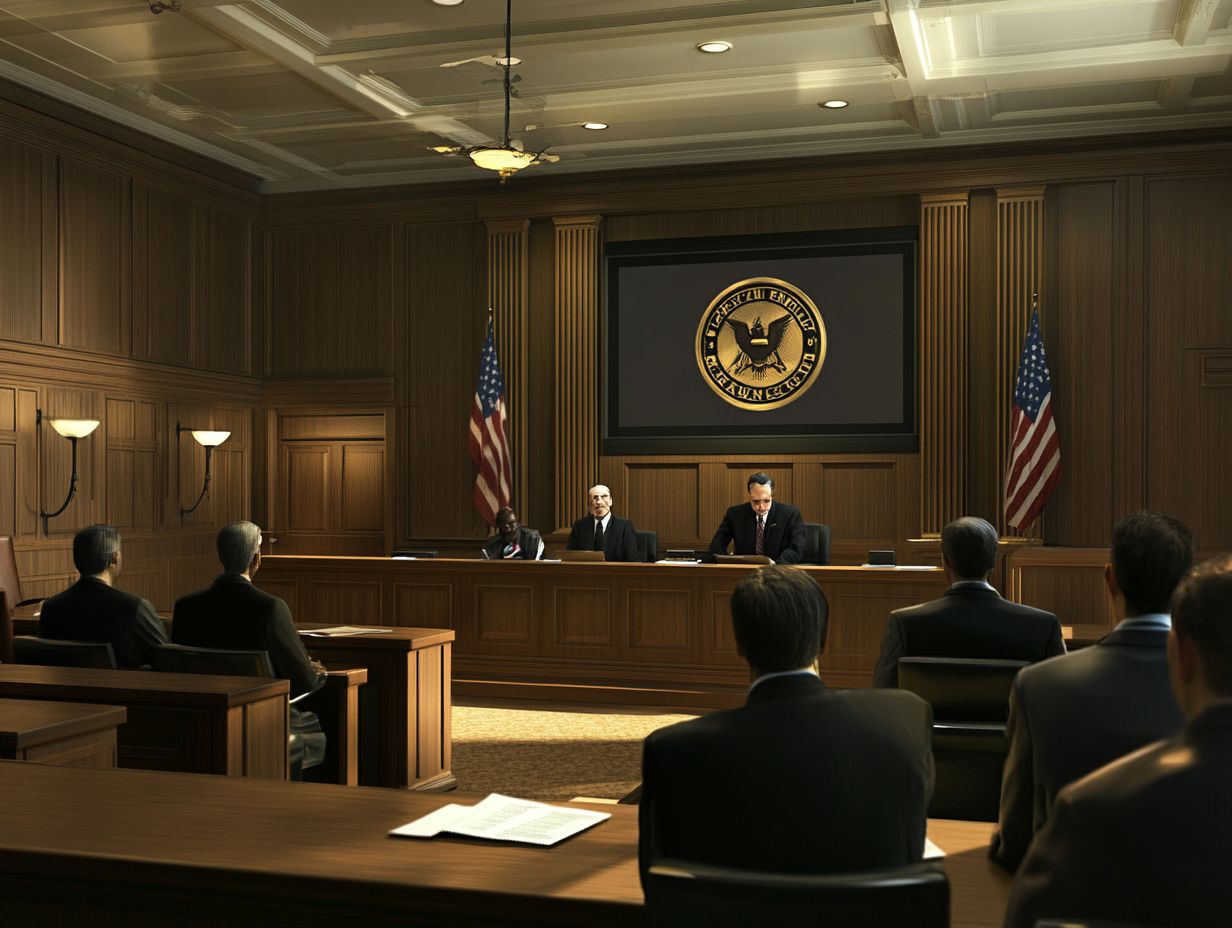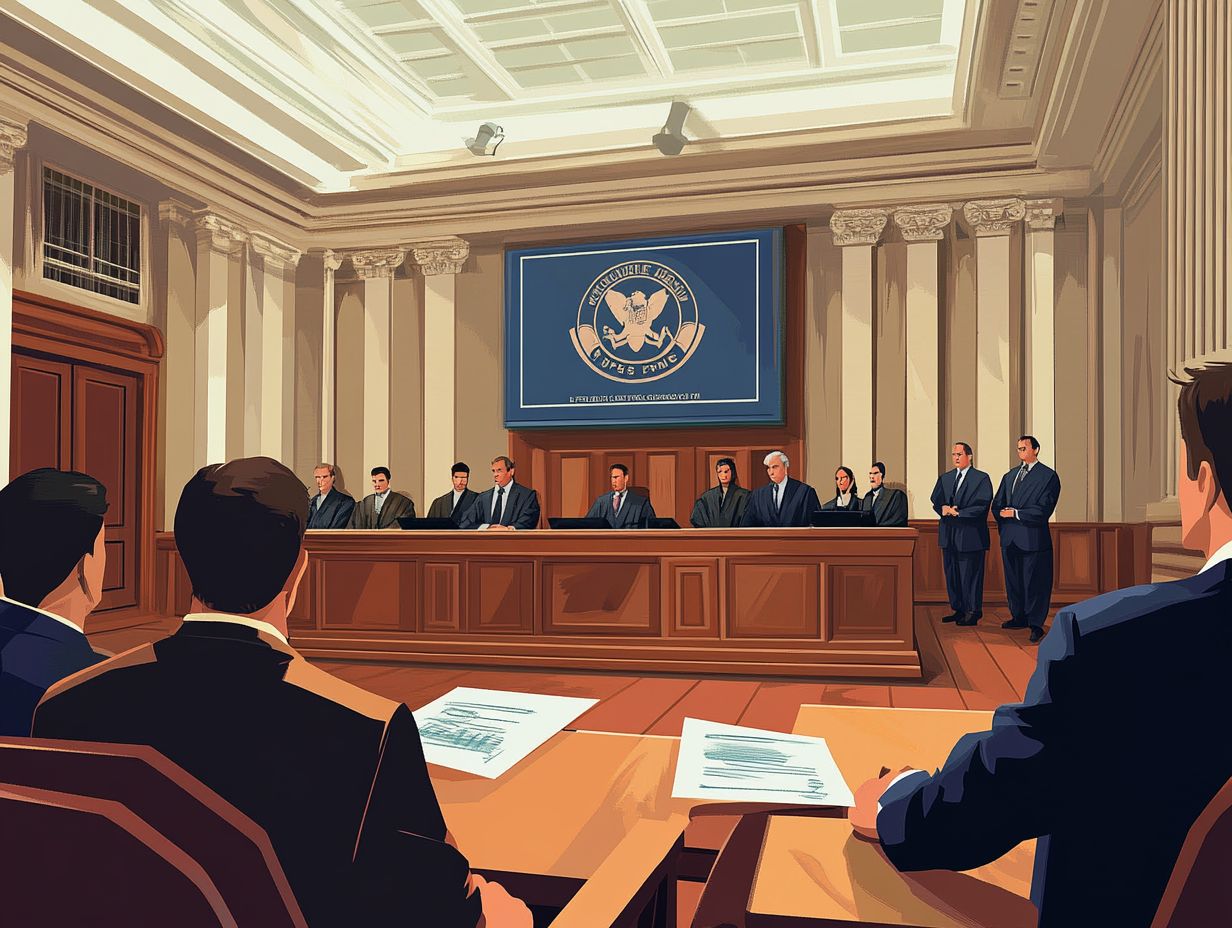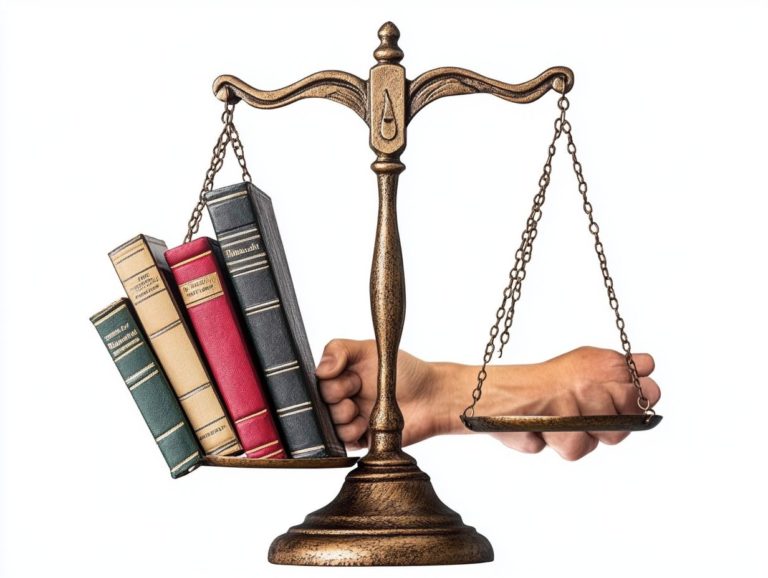The Role of the USPTO in IP Litigation
Intellectual Property (IP) is vital for safeguarding the creative and innovative efforts of both individuals and businesses. Understanding the various types of IP and their importance is essential for navigating today s competitive landscape.
This article delves into the United States Patent and Trademark Office (USPTO) unpacking its history, purpose, and pivotal role in IP litigation. You ll find insights into the litigation process, the steps involved in filing a lawsuit, and effective strategies for defending against IP claims.
Recent developments that impact both businesses and individuals will also be explored. Explore this material and empower yourself to tackle IP challenges today!
Contents
- Key Takeaways:
- Understanding Intellectual Property (IP)
- What is the USPTO?
- The USPTO’s Role in IP Litigation
- How to File a Lawsuit with the USPTO
- Defending Against IP Litigation
- Recent Developments in USPTO and IP Litigation
- Frequently Asked Questions
- What is the USPTO’s role in IP litigation?
- How does the USPTO assist in IP litigation?
- Can the USPTO make decisions in IP litigation?
- What is the role of the USPTO in patent infringement cases?
- Does the USPTO only handle litigation involving patents?
- Can the USPTO help with alternative dispute resolution for IP disputes?
Key Takeaways:

The USPTO plays a crucial role in protecting and enforcing intellectual property rights in the United States, as detailed in The Role of the USPTO: A Guide for Inventors.
Understanding the types of IP and the litigation process can help individuals and businesses effectively navigate the legal system and defend against IP lawsuits.
Recent developments in USPTO and IP litigation have significant implications for businesses and individuals, making it necessary to stay updated on changes and developments in this area.
Understanding Intellectual Property (IP)
Understanding Intellectual Property (IP) is vital if you aim to encourage new ideas and drive economic growth, particularly within the framework of the United States Patent System.
Intellectual property rights (IPR) are laws that protect creators’ inventions and creations. This system not only spurs innovation but also plays a pivotal role in maintaining the integrity of the global IP ecosystem.
Navigating this landscape effectively enhances your ability to advocate for policy leadership. It also ensures that technical assistance aligns seamlessly with trade-related policies.
A robust understanding of IPR helps you enforce rights against counterfeit medications while cultivating a culture of public awareness and education about the significance of IP protection.
Types of IP and Their Importance
The primary types of intellectual property (IP) you should be aware of include patents, trademarks, copyrights, and trade secrets. Each serves a distinct role in safeguarding creators’ rights and promoting innovation.
Patents are essential for inventors like you, granting exclusive rights over your inventions and ensuring that others cannot replicate or profit from your ideas without your consent.
Trademarks are vital for establishing brand identity. They allow you to register your logos and names, protecting your brand from unauthorized use.
Licensing your intellectual property opens avenues for monetization. Copyright protects your artistic creations, ensuring that you retain control over your work.
In today s globalized market, brand protection through anti-counterfeiting measures has become increasingly important. This helps maintain the integrity and reputation of your legitimate products against imitations.
What is the USPTO?
The United States Patent and Trademark Office (USPTO) is a pivotal federal agency dedicated to overseeing the nation s patent laws and trademark registration processes.
By safeguarding the intellectual property rights of inventors and businesses, the USPTO plays a crucial role in fostering innovation and maintaining a fair marketplace.
History and Purpose
The history of the United States Patent and Trademark Office (USPTO) is intertwined with the very founding of the nation. It serves as a cornerstone for establishing a legal framework that safeguards intellectual property rights, ultimately driving innovation and economic growth.
This framework has not only supported the inventive spirit that defined the early years of the United States but has also set the stage for a dynamic system that aligns with international agreements like the Patent Cooperation Treaty (PCT) and the Trade-Related Aspects of Intellectual Property Rights (TRIPS).
By fostering a stable environment for inventors and businesses, the USPTO has consistently adapted to the evolving landscape of technology and commerce. Its commitment to harmonizing U.S. patent law with global standards underscores a dedication to enhancing competitiveness in an increasingly interconnected world. This ensures that innovation flourishes both at home and abroad.
The USPTO’s Role in IP Litigation

The USPTO serves a vital function in the landscape of IP litigation, providing crucial resources and guidelines for understanding the role of the court in IP litigation and the judicial mediation process.
It also offers training to educate the public, deepening understanding and ensuring compliance. This proactive approach helps lawyers and empowers individuals and organizations to confidently navigate the intricate world of intellectual property.
Overview of the Litigation Process
The IP litigation process unfolds in several key stages, including initial filings, discovery, and the possibility of court mediation. These stages may lead to resolutions through alternative dispute resolution mechanisms.
Each phase is essential for understanding how intellectual property rights are enforced. Initially, you ll need to submit formal complaints and supporting documentation that clearly outline your claims and defenses.
Next comes the discovery stage, where both sides gather evidence. This can involve written questions that one party sends to another party to gather information, depositions, and requests for documents, all aimed at painting a complete picture of the case.
If you and the opposing party find common ground, you may enter court mediation. In this process, a neutral mediator facilitates negotiations, fostering a collaborative atmosphere that allows for the exploration of settlement options.
These enforcement initiatives are crafted not only to protect IP rights but also to promote efficient resolutions that save you time and resources.
How to File a Lawsuit with the USPTO
When you file a lawsuit with the USPTO, it’s essential to thoroughly understand the requirements and processes tied to both patent law and trademark registration.
This knowledge will enable you to navigate the complexities involved effectively.
Steps and Requirements
The steps and requirements for filing a lawsuit with the USPTO involve several key actions, such as preparing necessary documents and adhering to specific patent laws and trademark registration protocols.
Embarking on this journey requires you to grasp various components. Initially, you’ll need to gather detailed evidence and relevant documentation to establish your case. This may involve conducting prior art searches, outlining patent claims, and compiling information related to trademark infringement.
Next, ensure your compliance with USPTO rules by meticulously reviewing the guidelines for submission formats and deadlines.
Once you have all your information compiled, submit your materials online through the Electronic Filing System. Make sure your documents are perfectly filled out to avoid delays or dismissals this step is crucial!
Throughout this process, consulting with legal experts can streamline your efforts and enhance the likelihood of a favorable outcome.
Defending Against IP Litigation
Defending against IP litigation necessitates strategic planning and a comprehensive understanding of the enforcement resources at your disposal. This includes exploring options for alternative dispute resolution and court mediation to effectively navigate potential challenges.
Strategies and Considerations

When crafting strategies to shield yourself from IP litigation, keep several key factors in mind, such as the enforcement resources available and the possibility of court mediation or alternative dispute resolution.
Evaluate both the strengths and weaknesses of your intellectual property while anticipating the moves of the opposing party.
Consider tactical options like filing counterclaims or pursuing summary judgment to proactively address any potential infringements. Engaging expert witnesses and conducting thorough market analyses can significantly enhance your defense, highlighting the originality and value of the IP in question.
It’s crucial to understand the potential costs of prolonged litigation. Carefully weigh your options to either settle or engage in a full legal battle, ensuring that whichever route you choose aligns with your broader business objectives and appetite for risk.
Recent Developments in USPTO and IP Litigation
Recent developments within the USPTO and the realm of IP litigation have been profoundly shaped by technological advancements. These changes have ushered in new enforcement guidelines and practices designed to enhance the trademark registration process.
As you navigate this evolving landscape, staying informed about these innovations can give you a distinct advantage in protecting your intellectual property.
Impact on Businesses and Individuals
The recent developments in USPTO and IP litigation hold significant implications for both businesses and individuals, influencing how they perceive enforcement resources and highlighting the importance of understanding the role of licensing in litigation as well as the critical need for public education on intellectual property rights.
As a business, you may find yourself reevaluating your strategies for protecting intellectual property in a landscape characterized by heightened scrutiny and shifting legal frameworks. Individuals, too, are urged to deepen their understanding of their rights and responsibilities in this realm.
This dynamic environment necessitates that organizations implement comprehensive training programs designed to enable employees to recognize and respect intellectual property while taking proactive steps toward compliance.
An ongoing dialogue among stakeholders is essential, ensuring that everyone has access to resources that enhance understanding of the implications of changes in IP law and equips them to navigate these complexities effectively.
Frequently Asked Questions
What is the USPTO’s role in IP litigation?
The USPTO, or United States Patent and Trademark Office, serves as the federal agency responsible for granting patents and trademarks. In IP litigation, the USPTO plays a crucial role in determining the validity and enforceability of intellectual property rights.
How does the USPTO assist in IP litigation?

The USPTO can assist in IP litigation in a variety of ways. They can provide evidence and expert testimony regarding the validity of a patent or trademark, help with discovery requests, and offer guidance on proper claim construction. Understanding the role of IP litigation can further clarify their support in these matters.
Can the USPTO make decisions in IP litigation?
No, the USPTO does not have the authority to make decisions in IP litigation cases. They can provide information and assistance, but the ultimate decision is left to the courts.
What is the role of the USPTO in patent infringement cases?
The USPTO’s role in patent infringement cases is to determine the validity of a patent and whether it has been infringed upon. They can also assist with determining the scope of a patent’s claims and provide evidence in the case. For more insights, you can explore what to expect during an IP litigation process.
Does the USPTO only handle litigation involving patents?
No, the USPTO also handles trademark litigation. They assist in determining the validity and enforceability of trademarks in infringement cases and can provide evidence and expert testimony.
Can the USPTO help with alternative dispute resolution for IP disputes?
Yes, the USPTO offers various alternative dispute resolution services, such as mediation and arbitration, for resolving IP disputes. These options can often be more cost-effective and efficient than traditional litigation.






